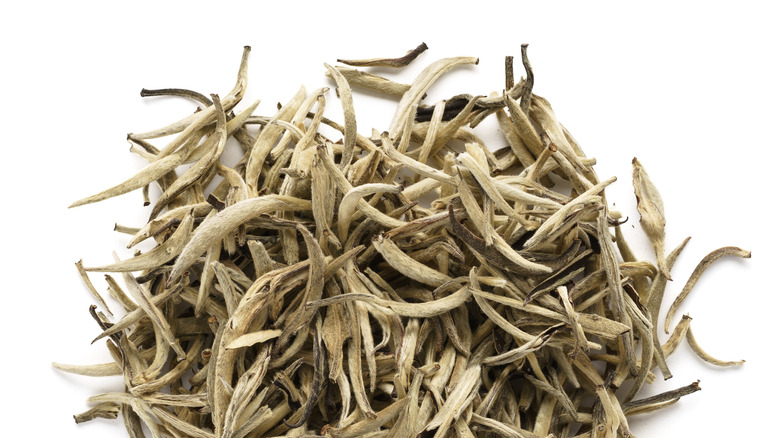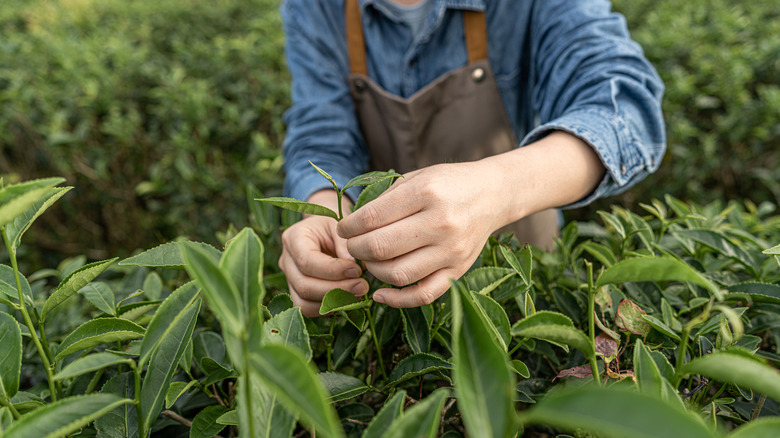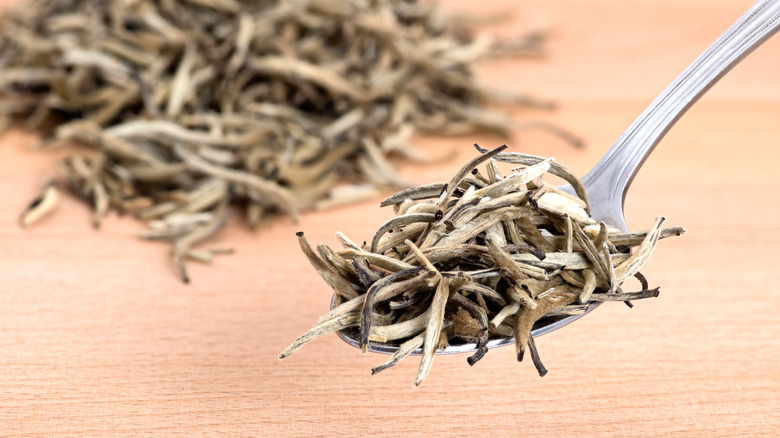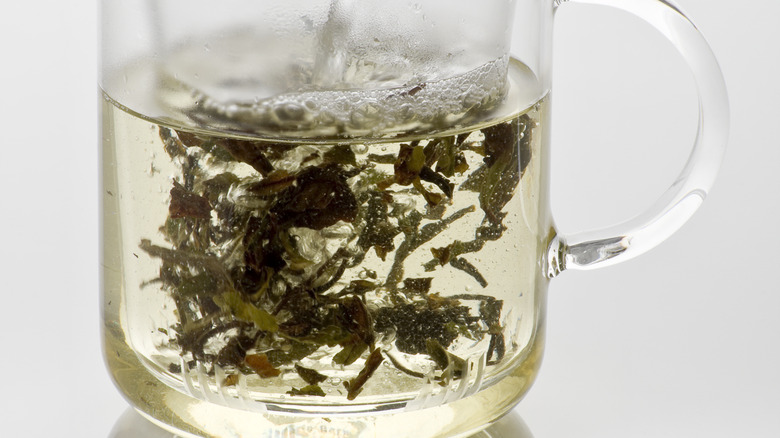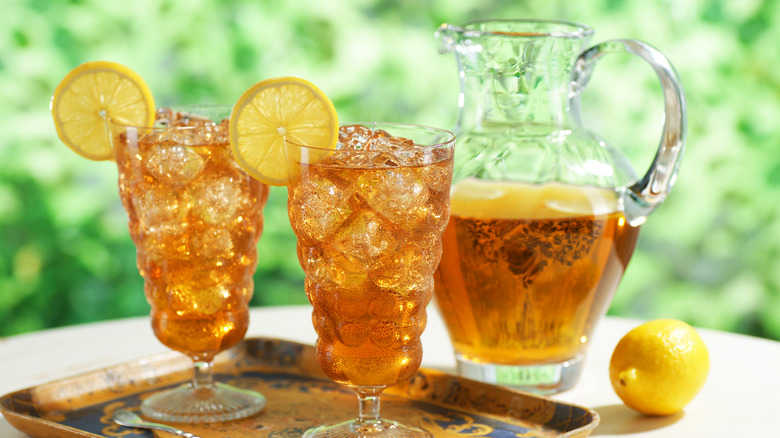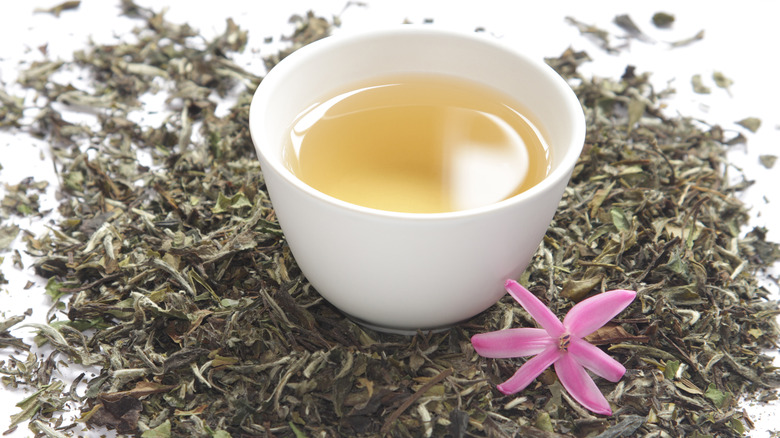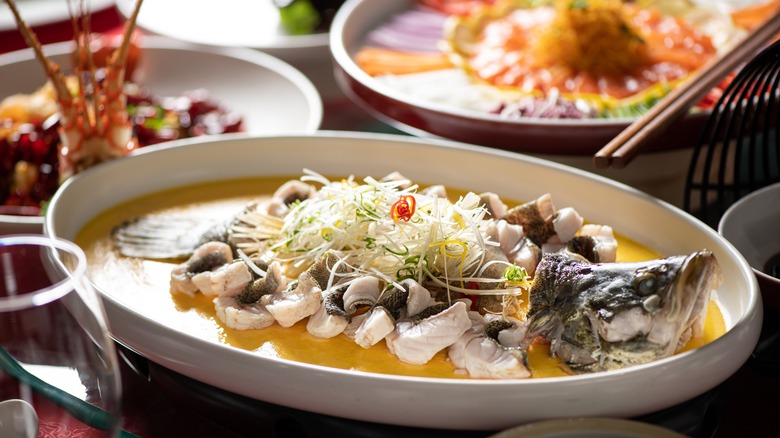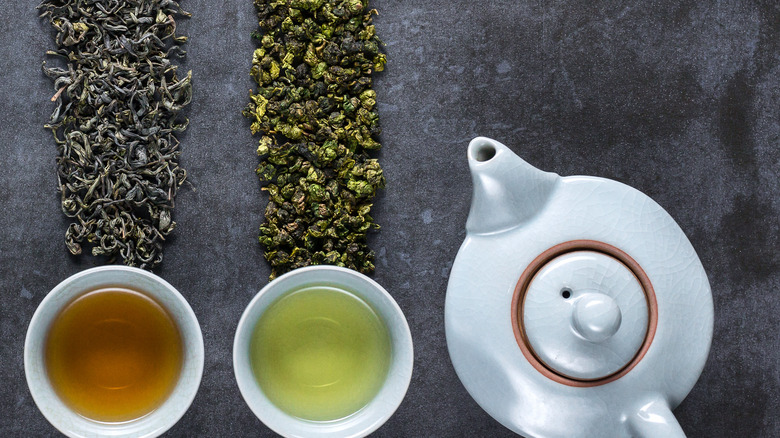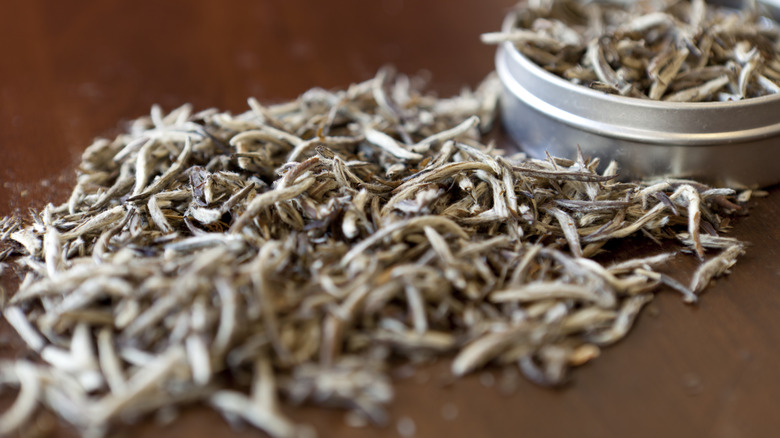White Tea: What It Is And The Different Types, Explained By Loose-Leaf Expert
Other than water, tea is the most consumed beverage in the world. It's affordable, healthy, refreshing, and delicious, and there are endless types of tea to try. Tea is embedded in worldwide cultures and traditions, from Japanese tea ceremonies to Southern sweet tea. We even stood up to the Brits by throwing a little tea party in Boston to show them we wouldn't pay their taxes any longer.
White tea has been around for over 1,000 years, but even frequent tea drinkers may not know how it differs from the more common black and green teas. White tea is less imbibed and less understood, but it is a tea variety grown and produced with great care, which results in a wonderfully light and bright cup of tea. I was first introduced to the enormous world of tea while working at Old Town Coffee Tea and Spice in Alexandria, Virginia, and then at the Random Tea Shop in Philadelphia, Pennsylvania. Even before trying white tea, I was drawn to the names on the labels, words that seemed to tell me something about what was inside that I did not yet understand: silver tips, long eyebrow, dragon phoenix pearls. They hinted at white tea's regal and storied past.
Now, I am a firm believer that any tea lover should add white tea to their collection. In fact, if you aren't a tea drinker, you should get some anyway.
What is white tea?
White tea is made from the leaves of the camellia sinensis plant. In fact, all real and caffeinated tea is. But white tea is processed and prepared in unique ways that make it lighter, fresher, and more naturally sweet than other tea varieties. White tea was a favorite delicacy of Chinese emperors over 1,000 years ago, and while it has become far more widely available, it retains grandeur in its elegant and delicate leaves.
Traditionally grown and processed in the Fujian province of China, white tea is now made in various parts of Asia using similar techniques. Traditional white tea is made from leaf buds that have not fully opened. It undergoes minimal processing and oxidization; it is plucked, dried, and then sorted. The pale, light leaves are covered in a fine white hair that gives white tea its name.
While the subtle flavors and aromas of white tea vary based on its type and quality, it generally has light floral, sweet notes and produces a pale, golden yellow cup when brewed. Generally, it is not advisable to flavor white tea with additional ingredients or oils. White tea's delicate taste and aroma make it less suitable for strong added flavors than black tea. Nonetheless, some tea companies do make blended teas like Earl Grey or fruit infusions using white tea.
How this type of tea is processed
The ethos of white tea is minimal preparation and intervention. The best white tea leaves are plucked in early spring when the plant's first blooms have not yet reached full maturity. The plucked leaves are then piled onto large outdoor bamboo trays to undergo a gentle drying process called withering. As they rest on the trays, they begin to lose their moisture slowly. The tea leaves are only partly withered to minimize oxidation. It involves a careful balancing act of removing moisture from the leaves by leaving them out in the sun without introducing too much air or heat. The partially withered leaves darken from green to brown while preserving and developing their natural flavors and aromas.
Finally, they are dried under low flame heat to stop oxidation and deepen their flavor further. Once dried, the leaves are sorted by hand. Much of the sorting process involves removing any leaves that appear unsuitable for drinking. The rest of the tea leaves are carefully separated into five different grades before being packaged and sent worldwide.
Because white tea is processed with so little intervention, the conditions of the environment in which it was grown are more apparent in the final product's flavor than in more processed varieties of tea. Thus, the climate and soil makeup of a tea farm are critical. This is one reason some believe that white tea grown outside of the Fujian province of China is not truly white tea.
The different types of white tea
The five grades of white tea are silver needle, white peony, tribute eyebrow, noble eyebrow, and Fujian new craft. Grades are determined based on the tea leaves' appearance and quality.
The highest quality white tea, silver needle, is made from the youngest leaves, which should be unbroken with silver tips. It is followed by white peony, which has darker leaves due to its later flush. The flush of a tea is the harvest; for example, the first flush of a tea plant is the season's first harvest. These first two grades are the most common in specialty tea shops. The other grades, however, are still quite drinkable. They are leaves that received more oxidation, were broken into smaller pieces, or were produced from a later flush. The exception is Fujian new craft, which is in a separate grade due to an additional step in its processing.
While white tea leaves are typically prized for their elegant, wispy appearance, you may also encounter white tea leaves that have been formed into a ball, usually called tea pearls. These white tea leaves have been deftly hand-rolled and will unfurl as they steep in the hot water. Jasmine white tea is another common option. This white tea is scented with jasmine flowers, which are removed before packaging the leaves. This is a traditional and very old way of adding flavor to white tea, so there are many varieties of jasmine white tea.
How to prepare it hot
As with all tea, it is best to start with fresh water when making a cup of white tea. White tea is delicate and thus needs to be brewed at a lower temperature than black or green tea. The water temperature should be between 160 and 185 degrees Fahrenheit. Anything hotter will brew an astringent cup of tea. If you don't have a thermometer, look for pinpoint-sized bubbles rising in the water.
Just as white tea needs a reduced temperature compared to other teas, its steeping time should be reduced as well. The tannins in white tea will over-extract quickly, imparting bitterness earlier than more processed teas. Generally, the steeping time should be one to three minutes. If you are using loose-leaf white tea, use about a tablespoon of leaves per 8 ounces of hot water. You can use a reusable tea strainer, disposable tea bags, or any sieve; just ensure you can easily remove the leaves once the steeping time is complete. Some tea drinkers like to steep white tea leaves for a second or even third infusion. This can be done by simply reusing the same tea leaves and repeating the steeping process. Just be aware that the caffeine content and flavor will reduce with each infusion.
It is generally not recommended to add milk or sugar to white tea. Milk will dilute the mild flavor of the tea, while sugar will overpower it.
How to make iced white tea
Making iced white tea is no different from making other kinds. You aim to produce the same full, fragrant brew you can get when making tea hot while creating an ice-cold and refreshing glass of tea that doesn't taste like mostly water. The only real difference with white tea is that it's easier to accidentally create an overly mild cup. Because white tea's flavors are already lighter than those of black or green tea, any watering down will be more detrimental to the final product.
In short, when making iced tea, time is your best friend. Brew the tea with hot water as normal and let it cool completely. Then, chill it in the fridge before adding ice. You can make a double-strength brew and cool it immediately with ice for a quicker solution. When using this method, the best way to make a strong tea base is by doubling the amount of tea leaves. Do not try to steep the tea for more than three minutes in an attempt to strengthen the flavor. After around three minutes, the bitter and astringent flavors will begin to extract from the leaves. Once the hot strong tea is ready, pour it over ice for a dilution that will balance and cool the drink.
Cold brewing tea by steeping it in water overnight is the method of choice for some. However, it will produce a very different and milder flavor than hot-brewed tea.
What white tea tastes like
White tea has a decidedly mild flavor, but each variety and preparation style creates something distinct. The flavors are subtle and are best described as notes — think of it like wine or specialty coffee. Silver needle white tea is slightly sweet and lightly herbal, with a fresh taste that comes from its minimal processing. It has notes of juicy fruits, like peaches and citrus. White peony tea has a stronger, more perfumed flavor and aroma. Other grades are slightly grassier or wheat-like, and their sweetness has more honey-like notes than silver needle or white peony. Their flavor is bolder and can even taste slightly roasted, almost like some green teas or oolongs.
Aged white teas, which have been stored for several years to develop more robust flavors, have their own unique profiles. They tend to have notes of dried fruit, like raisins and prunes, and their sweeter flavor can even have notes of chocolate or caramel.
The nutritional profile of white tea
White tea provides a lot of potential benefits beyond the simple enjoyment of a well-made cup of tea. Like other teas from the camellia sinensis plant, white tea is caffeinated. Therefore, it provides the same lift as other drinks containing caffeine. However, due to its nature as young, unprocessed leaves, it usually has less caffeine than black or green tea, making it a great choice for those who are trying to cut back.
While there is more research on the effects of green tea on the body, studies show that there are numerous health benefits associated with white tea. Its lack of oxidization means that it is among the highest in antioxidants of all tea varieties. This may be one reason why white tea may be linked to reduced risk of heart disease and even cancer. It also contains catechins, which are thought to help boost your metabolism and assist in weight loss. Catechins also decrease plaque development, meaning that white tea can help combat cavities.
Beyond the promising research into the complex ways white tea may be beneficial, it is a nutritious way to enjoy a beverage. As it is a simple combination of water and tea leaves, white tea is a natural, unprocessed product with no sugar or additives.
Cooking with this type of tea
While strongly flavored teas like Earl Grey or matcha find their way into many baking recipes, white tea is less suited for the task. Its subtle flavor is easily overwhelmed by additional strong flavors and sweeteners. However, it can absolutely enhance baked goods when its unique profile is considered. White tea pairs well with fruity and citrusy flavors, which will complement each other in a dessert. You can use white tea to infuse dairy products, and once cooled, the cream or milk can be used for frostings, whipped cream, and glazes.
White tea can also be an incredible addition to cocktails. Spirits like vodka can be infused with white tea, or it can be made into a white tea simple syrup. Its floral flavor pairs well with gin and vermouth.
Tea also has savory applications. Black tea is used in traditional Chinese cooking as a smoking and flavoring method for meat, but it would be a waste to use delicate white tea in this way. Instead, think of it as a water enhancer in recipes. White tea is a clever vehicle for adding dimension to steamed dishes. For example, you can cook rice in white tea or poach fish for a delicious and complex aroma. You can also substitute it for stock — enhancing the broth in tortellini en brodo — or add it to other soup recipes.
White tea vs. green tea
Both green and white tea are lauded for their bright, fresh flavors, which result from unprocessed leaves. They are also both high in antioxidants and free radicals, so they boast many potential health benefits. Green tea has herbal, fruity notes, as does white tea.
However, there are significant differences between the two kinds of tea. Like white tea, green tea originated in China, but it emerged much earlier. In fact, green tea is the first kind of tea people drank, having been first brewed over 4,000 years ago. Green tea is steamed or pan-cooked after being harvested to preserve its green color. As this type of tea has been around for quite some time, it has seemingly endless varieties and is made in all tea-producing parts of the world.
Green tea also has a much stronger flavor than white tea, and its sweetness is bolder and more vibrant. The color of the leaves and the cup of tea they produce depends on the tea itself, but green tea typically makes for a deep golden brew, noticeably darker than white tea. It holds up better to additions like milk or dried fruit than white tea, which shines best on its own. In general, green tea has more caffeine than white tea — about 35 to 70 milligrams compared to 30 to 55 milligrams in an 8-ounce cup. Though caffeine levels depend on both the tea itself and the steeping methodology.
Where to buy this variety of tea
White tea is grown in Asia, so you'll need to go there for a local brew. However, most tea shops will have some imported tea available. While your local grocery store likely sells boxes of white teabags, it's worth seeking out a tea importer either online or in-store. They should be able to provide you with the tea grade, as well as the tasting notes and other details like harvest date and location. Most tea shops sell their tea loose-leaf by weight, and it will generally be of higher quality than the crushed leaves to be found in prepackaged teabags.
While ordering white tea online is convenient and, for many, the only option for high-quality white tea, there are benefits to visiting a local shop, if possible. The quality of white tea, from the moment it is harvested, is partially determined by appearance. By seeing the leaves in person, you can note if you are actually getting what you are paying for. It's the best way to know if the silver needle tea you are ordering has full, silvery tips with the needles unbroken, for example.
If you would like to buy a cup of white tea before making it at home, tea houses are your best bet. They will bring you a pot of tea that has already been perfectly brewed to the specifications of the tea itself, so you can be sure you are drinking your white tea as it was meant to be drunk.
How to store white tea
Loose-leaf tea should be stored in a dark, sealed container. The reduced exposure to air and sunlight helps prevent loss of flavor. Ideally, tea is vacuum sealed to ensure air does not continue to degrade the leaves. Though tea, if kept dry, will not go bad, its flavor and aroma will diminish after roughly one year. Even if you are a frequent tea drinker, it is best to buy tea in smaller amounts (say, by the ounce and not by the quarter pound), because it is difficult to maintain the freshness of stored tea. The container and storage location of the tea should also be very dry, as moisture can cause mold or mildew to appear on the leaves.
Due to its delicate and light flavor, white tea should not be stored next to strong-flavored teas or other pantry items like spices. In the same vein, thoroughly clean any container in which you plan to store white tea. White tea will absorb the intense flavors around it, making for a strange cup of tea at best.

